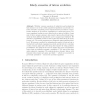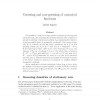87 search results - page 12 / 18 » How Large is the Set of Disjunctive Sequences |
WINE
2009
Springer
14 years 1 months ago
2009
Springer
We propose approximation algorithms under game-theoretic considerations. We indroduce and study the general covering problem which is a natural generalization of the well-studied m...
RECOMB
2005
Springer
14 years 7 months ago
2005
Springer
Whether common ancestors of eukaryotes and prokaryotes had introns is one of the oldest unanswered questions in molecular evolution. Recently completed genome sequences have been u...
AAAI
2004
13 years 8 months ago
2004
This paper deals with automatically learning the spatial distribution of a set of images. That is, given a sequence of images acquired from well-separated locations, how can they ...
ESANN
2004
13 years 8 months ago
2004
When we talk about using neural networks for data mining we have in mind the original data mining scope and challenge. How did neural networks meet this challenge? Can we run neura...
APAL
2007
13 years 7 months ago
2007
It is possible to control to a large extent, via semiproper forcing, the parameters (β0, β1) measuring the guessing density of the members of any given antichain of stationary s...


